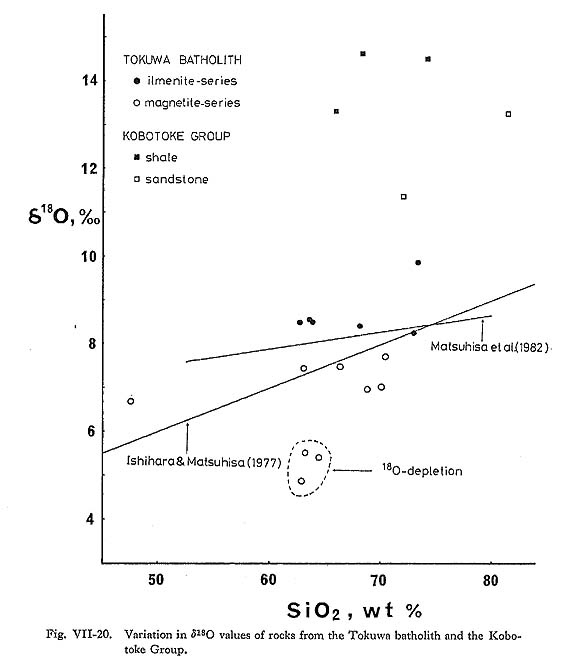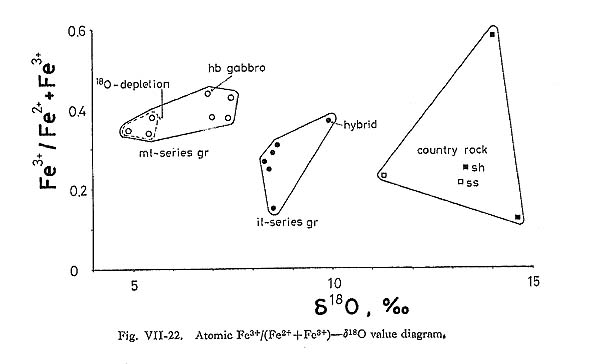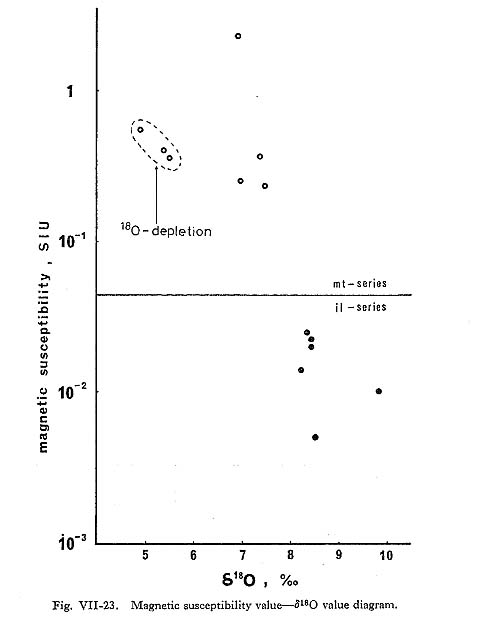CHAPTER VII
Whole-Rock Chemistry
4) Oxygen Isotopic Composition
|
Oxygen isotopic studies are quite useful in understanding the degree of anatexis or assimilation of sedimentary rocks during the development and evolution of granitic magmas for the following reasons : (1) Magmas derived from the upper mantle have very uniform and characteristic isotopic compositions; δ18O=+5.7±0.2‰ (Matsuhisa, 1978). (2) Simple fractional crystallization cannot produce any major changes in δ18O in later differentiates, because the equilibrium isotopic fractionations between silicate liquids and minerals are very small at magmatic temperatures (Taylor, 1968; Anderson et al., 1971). (3) Sedimentary rocks typically have much higher δ18O values than deep-seated igneous rocks. For example, the δ18O values of shale are commonly in the range of about +12 to +20‰ (Taylor, 1978). Oxygen isotopic compositions of 21 representative samples from the Tokuwa batholith and the Kobotoke Group were measured following the procedures of Sakai and Honma (1966) and Matsuhisa et al. (1971). The oxygen isotopic data obtained are shown in Table VII-7 and plotted against SiO2 contents in Fig. VII-20. It is remarkable that all ilmenite-series granitoids have δ18O values (in permil relative to standard mean ocean water (SMOW)) of higher than +8.3‰ and are clearly distinguished from magnetite series rocks with low-δ18O values. Since alteration minerals such as sericite in plagioclase as well as chlorite and epidote in biotite were microscopically observed in three δ18O-depleted samples, this depletion probably resulted from isotopic exchange with heated meteoric groundwater. A meteoric-hydrothermal convective circulation system in the epizonal portion of the batholith might locally produce rocks with low δ18O values during subsolidus exchange (Taylor, 1978), particularly near the southern parts of the batholith, where two of the three δ18O-depleted samples were collected. There is another possibility that granitoids from the southern parts of the batholith might have been affected by assimi lation of the Misaka Group rocks composed mainly of altered volcanic rocks; however, attention will be focussed on the formation of ilmenite-series granitoids.
Data indicating extreme δ18O-depletion due to alteration will be eliminated from the following discussion. Figure VII-20 clearly shows a difference of δ18O values between the two series of granitoids. The effect of fractional crystallization on the δ18O variation is small, less than 0.6‰ in magnetite-series rocks. The two lines in Fig. VII-20 indicate the boundary between the two series of Japanese granitoids proposed by Ishihara and Matsu hisa (1977) and Matsuhisa et al. (1982). Figure VII-21 demonstrates the positive correlation between the oxygen isotopic com positions of rocks and the contents of pelitic xenoliths. The same relation between 87Sr/86Sr and contents of pelitic xenoliths was reported by Shimizu (1983). Hence, Fig. VII-20 probably indicates that ilmenite-series granitoids significantly involved high-δ18O mate rials such as the Kobotoke Group sedimentary rocks, particularly shale. If this interpretation is correct, the oxygen isotopic data for the Tokuwa batholith rocks can be used to estimate the degree of assimilation. Simple mixing model calculations show a mixing ratio of 0.24 (volume of shale/volume of magnetite-series melt) needed to produce ilmenite-series granitoids. This value is almost the same as the value obtained by calculations using [Ce]N/ [Yb]N ratios, and nearly concordant with the results of calculations using data on major and minor elements with significant differences between the two series of rocks based on statistic testing (see Table VIII-4).
A correlation is obtained between the δ18O values and atomic Fe3+/(Fe2++Fe3+) ratios (Fig. VII-22). The values of magnetic susceptibility of the Tokuwa batholith rocks are correlated with the whole-rock δ18O data, yielding a pronounced negative correlation (Fig. VII-23). In this case, the values of magnetic susceptibility might also indicate the degree of contribution of sedimentary rocks as well as the oxygen isotopic data. Conse quently the magnetic susceptibility and δ18O data from the Tokuwa batholith and the wall rocks indicate that contamination from the aureole is important at the exposed level.
|





